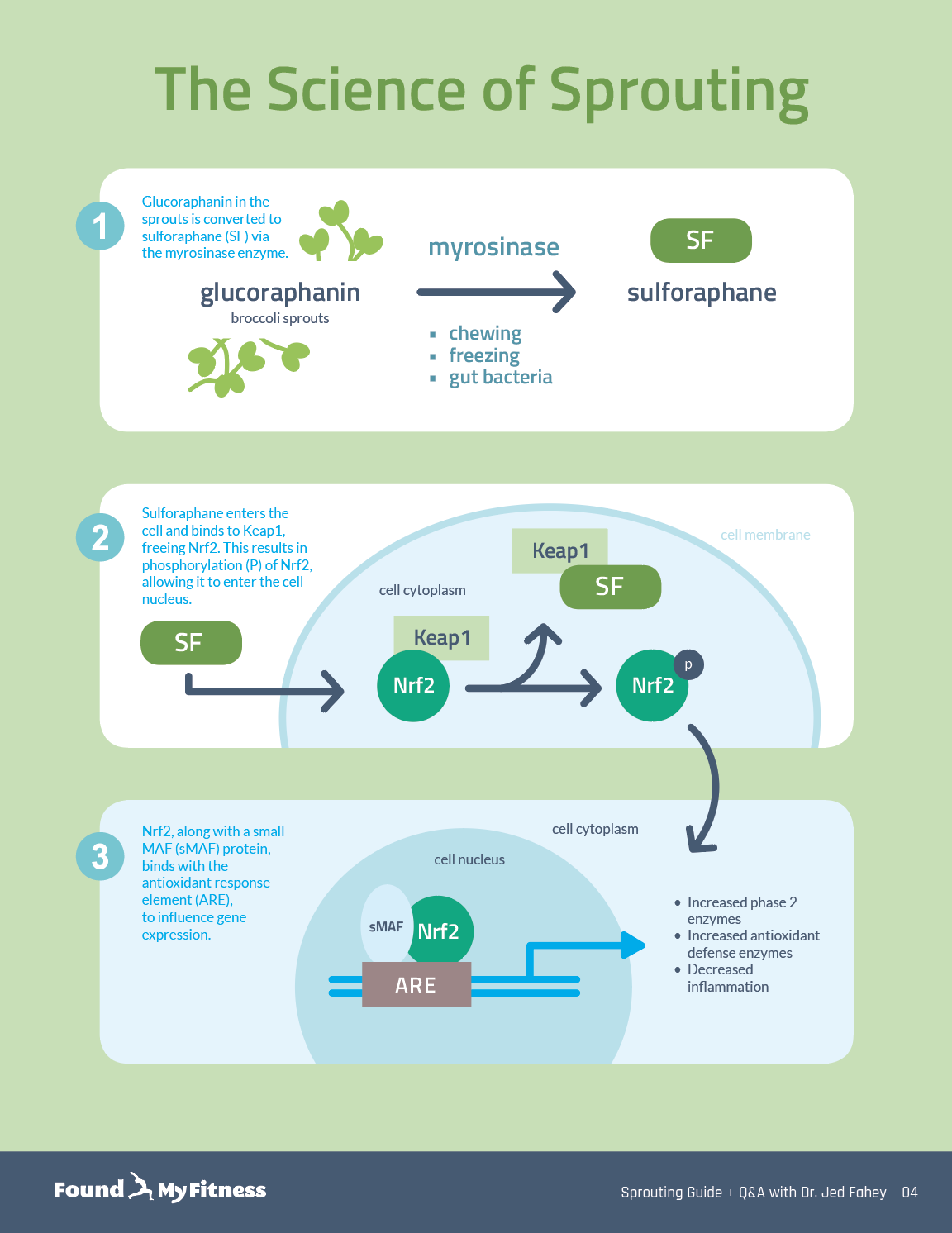Sulforaphane and benzene detoxification (relevance in smokers and for air pollution) | Jed Fahey
Enter your email to get our 15-page guide to sprouting broccoli and learn about the science of chemoprotective compount sulforaphane.
Broccoli sprouts are concentrated sources of sulforaphane, a type of isothiocyanate. Damaging broccoli sprouts – when chewing, chopping, or freezing – triggers an enzymatic reaction in the tiny plants that produces sulforaphane.

Get the full length version of this episode as a podcast.
This episode will make a great companion for a long drive.
Benzene, an aromatic compound found in cigarette smoke and air pollution, is a known carcinogen. A 2014 study found that sulforaphane from a broccoli sprout beverage markedly increased urinary benzene excretion among people living in China, where air pollution levels are among the highest in the world. These findings suggest that sulforaphane administration via broccoli sprouts may be a useful chemoprotective strategy in areas where benzene exposure is high. In this clip, Dr. Jed Fahey describes a study that demonstrated sulforaphane's chemoprotective qualities against benzene exposure.
Rhonda: Yeah, I'm convinced, yeah. You know, and the other thing is smokers. Smokers get bladder cancer and that, you know...I think, first of all, people that smoke should quit smoking first and foremost, but if they don't quit smoking, I mean, I think they should be consuming broccoli sprouts like nobody's business because they're accumulating so much benzene and all sorts of carcinogens.
Jed: I used to know a seedsman, a guy who ran a seed company and he smoked like a chimney, smoked cigarettes, and when he learned about the broccoli sprouts story, he would eat a handful of broccoli, toast a handful of broccoli seeds and eat them. And he claimed that he was doing that to counterbalance the cigarettes. I couldn't advise him on that. Well, you mentioned benzene a number of times and we didn't talk about the China studies but with our colleague, Tom Kensler, and many others, we did a series of studies over the years starting in about 2002. Interestingly, it started out in an area of China, a subsistence farming area just north of Shanghai where there was a lot of aflatoxin exposure. And so we were looking at liver cancer risk, looking at biomarkers of liver cancer and excretion of aflatoxin adducts vis-à-vis intake of sulforaphane.
Over time, as those studies progressed, there was a series of studies. The liver cancer risks started to come down because they were exporting their contaminated grain to other parts of China from this region, and with globalization, they were importing more and more food. So their diet was becoming less aflatoxin-rich. But at the same time, of course, air pollution was going through the roof. And so the most recent of those studies we published in 2014 showed, really, a dramatic enhancement of the clearance of benzene, and acrolein, and other pollutant conjugates in lockstep with broccoli sprout extract consumption.
Rhonda: It was a 60% increase in excretion, which is just phenomenal. And it convinced me, like it definitely is a problem not only in China, but...
Jed: India.
Rhonda: India, yeah. I mean, but we've got air pollution here in the U.S. and I live next to a busy street. And I see all sorts of things accumulating in my place, you know. So I'm taking that for my benzene excretion, as well. So it's very powerful and it was just within 24 hours.
Jed: It's a dramatic effect and there... So that's an interesting public health dilemma. You can tell someone not to smoke. You can sort of say in the back of your mind, I would never say this out loud, but in the back of your mind, you can say, "They had it coming. The idiots wouldn't stop smoking." We never say things like that. It's not politically correct. But with air pollution, you've got...I mean, people are trapped whether it's highly educated people like you that are living on the street where you know there's pollution or people in the developing world where, you know...
Rhonda: You have to breathe.
Jed: You got to breathe.
Rhonda: You have to breathe and air pollution is...
Jed: You got to eat, and breathe, and sleep, and we can go on.
Rhonda: Yeah. it's becoming... It's an increasing problem and I've seen just more and more studies. You know, a lot of people have focused on the effects on respiratory inflammation and those sorts of, which are very obvious. But like I said, the other health disease risk that's really becoming evident with air pollution is actually heart attacks and stroke because it's causing... It's low-level chronic inflammation. You know, and that's, of course, where sulforaphane shines. You know, I mean, it's inhibiting NF-KappaB pathway, like you said, activating all these anti-inflammatory pathways. So it seems like a no-brainer. It would be nice to get something like that into China and India, broccoli sprout. Well, I guess in India, they've got moringa.
Jed: True, true. So if I were doing a sort of a similar sister study to the broccoli sprout air pollution study in India, I would want to do it with moringa.
The simplest unsaturated aldehyde, created by the burning of glycerol in animal fat. Acrolein, a toxic, colorless liquid, is a strong irritant for the skin, eyes, and nasal passages of humans. It has a disagreeable, acrid smell, easily recognizable as the odor associated with burning fat.
A family of carcinogenic toxins produced by certain fungi endemic to areas with hot and humid climates. Aflatoxins are commonly found in agricultural crops such as maize (corn), peanuts, cottonseed, and tree nuts. In people who are infected with hepatitis B, aflatoxin markedly increases the risk for liver cancer.[1]
An aromatic hydrocarbon compound produced during the distillation and burning of fossil fuels, such as gasoline. It is also present in the smoke from forest fires, volcanoes, and cigarettes. Benzene is a carcinogen that targets the liver, kidney, lung, heart, and brain and can cause DNA strand breaks, chromosomal damage, and genetic instability.
A measurable substance in an organism that is indicative of some phenomenon such as disease, infection, or environmental exposure.
A critical element of the body’s immune response. Inflammation occurs when the body is exposed to harmful stimuli, such as pathogens, damaged cells, or irritants. It is a protective response that involves immune cells, cell-signaling proteins, and pro-inflammatory factors. Acute inflammation occurs after minor injuries or infections and is characterized by local redness, swelling, or fever. Chronic inflammation occurs on the cellular level in response to toxins or other stressors and is often “invisible.” It plays a key role in the development of many chronic diseases, including cancer, cardiovascular disease, and diabetes.
An essential mineral present in many foods. Iron participates in many physiological functions and is a critical component of hemoglobin. Iron deficiency can cause anemia, fatigue, shortness of breath, and heart arrhythmias.
Also known as the drumstick tree or the horseradish tree. Moringa oleifera is rich in protein, micronutrients, and glucosinolates and is associated with a wide range of health benefits. It is a fast-growing, drought-resistant tree, native to the southern foothills of the Himalayas in northwestern India.
A chemical that causes Parkinson's disease-like symptoms. MPTP undergoes enzymatic modification in the brain to form MPP+, a neurotoxic compound that interrupts the electron transport system of dopaminergic neurons. MPTP is chemically related to rotenone and paraquat, pesticides that can produce parkinsonian features in animals.
A rapid-acting transcription factor that responds to harmful cellular stimuli, such as reactive oxygen species, IL-1B, bacterial endotoxin (lipopolysaccharide or "LPS"), ionizing radiation, and oxidized LDL. Incorrect regulation of NF-kB has been linked to cancer, inflammatory and autoimmune diseases, septic shock, viral infection, and improper immune development. Several viruses, including the AIDS virus HIV, have binding sites for NF-kB. In the case of HIV, the presence of NF-kB is believed to be involved in switching the virus from a latent to an active state.
An antibody that plays key roles in immunity. Secretory IgA is the most abundant antibody in the mucosal immune system, accounting for nearly 20 percent of serum immunoglobulin. It is crucial in protecting the intestinal epithelium from toxins and pathogenic microorganisms.
An isothiocyanate compound derived from cruciferous vegetables such as broccoli, cauliflower, and mustard. Sulforaphane is produced when the plant is damaged when attacked by insects or eaten by humans. It activates cytoprotective mechanisms within cells in a hormetic-type response. Sulforaphane has demonstrated beneficial effects against several chronic health conditions, including autism, cancer, cardiovascular disease, diabetes, and others.
The highest level of intake of a given nutrient likely to pose no adverse health effects for nearly all healthy people. As intake increases above the upper intake level, the risk of adverse effects increases.
Hear new content from Rhonda on The Aliquot, our member's only podcast

Listen in on our regularly curated interview segments called "Aliquots" released every week on our premium podcast The Aliquot. Aliquots come in two flavors: features and mashups.
- Hours of deep dive on topics like fasting, sauna, child development surfaced from our enormous collection of members-only Q&A episodes.
- Important conversational highlights from our interviews with extra commentary and value. Short but salient.
Sulforaphane News
- Sulforaphane extends lifespan and healthspan in worms via insulin and insulin-like growth factor-1 signaling.
- Paul Saladino, MD explains how we may have overstated the health benefits of plants and especially sulforaphane
- NRF2 much of a good thing (December 2017)
- A pilot trial finds sulforaphane treatment increased glutathione levels in the blood & hippocampus region of the brain in healthy people.
- A new study found sulforaphane (found in broccoli sprouts) improved behavior & social responsiveness in children with autism.





































































